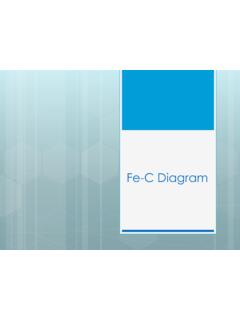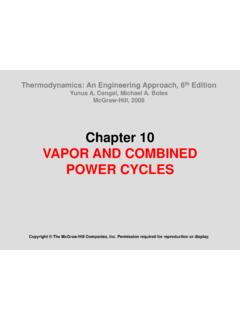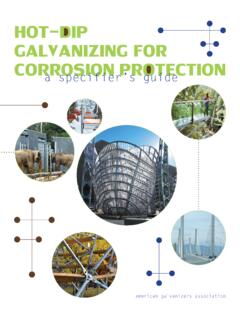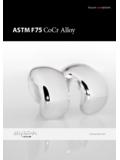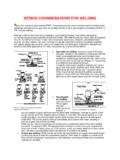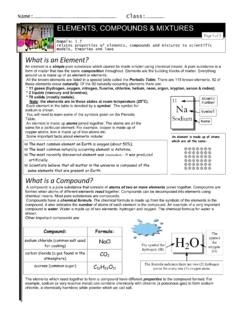Transcription of WELDING PROCESSES - Eastern Mediterranean University
1 WELDING PROCESSES WELDING WELDING Gas WELDING Fusion WELDING PROCESSES State WELDING Quality Considerations in WELDING 2013 John Wiley & Sons, Inc. M P Groover, Principles of Modern Manufacturing 5/e Two Categories of WELDING PROCESSES Fusion WELDING - coalescence is accomplished by melting the two parts to be joined, in some cases adding filler metal to the joint Examples: arc WELDING , resistance spot WELDING , oxyfuel gas WELDING Solid state WELDING - heat and/or pressure are used to achieve coalescence, but no melting of base metals occurs and no filler metal is added Examples: forge WELDING , diffusion WELDING , friction WELDING 2013 John Wiley & Sons, Inc. M P Groover, Principles of Modern Manufacturing 5/e Arc WELDING (AW) A fusion WELDING process in which coalescence of the metals is achieved by the heat from an electric arc between an electrode and the work Electric energy from the arc produces temperatures ~ 10,000 F (5500 C), hot enough to melt any metal Most AW PROCESSES add filler metal to increase volume and strength of weld joint 2013 John Wiley & Sons, Inc.
2 M P Groover, Principles of Modern Manufacturing 5/e What is an Electric Arc? An electric arc is a discharge of electric current across a gap in a circuit It is sustained by an ionized column of gas (plasma) through which the current flows To initiate the arc in AW, electrode is brought into contact with work and then quickly separated from it by a short distance 2013 John Wiley & Sons, Inc. M P Groover, Principles of Modern Manufacturing 5/e A pool of molten metal is formed near electrode tip, and as electrode is moved along joint, molten weld pool solidifies in its wake 2013 John Wiley & Sons, Inc. M P Groover, Principles of Modern Manufacturing 5/e Arc WELDING Manual Arc WELDING and Arc Time Problems with manual WELDING : Weld joint quality Productivity Arc Time = (time arc is on) divided by (hours worked) Also called arc-on time Manual WELDING arc time = 20% Machine WELDING arc time ~ 50% 2013 John Wiley & Sons, Inc.
3 M P Groover, Principles of Modern Manufacturing 5/e Two Basic Types of Arc WELDING Electrodes Consumable consumed during WELDING process Source of filler metal in arc WELDING Nonconsumable not consumed during WELDING process Filler metal must be added separately if it is added 2013 John Wiley & Sons, Inc. M P Groover, Principles of Modern Manufacturing 5/e Consumable Electrodes Forms of consumable electrodes WELDING rods ( sticks) are 9 to 18 inches and 3/8 inch or less in diameter and must be changed frequently Weld wire can be continuously fed from spools with long lengths of wire, avoiding frequent interruptions In both rod and wire forms, electrode is consumed by the arc and added to weld joint as filler metal 2013 John Wiley & Sons, Inc.
4 M P Groover, Principles of Modern Manufacturing 5/e Nonconsumable Electrodes Made of tungsten which resists melting Gradually depleted during WELDING (vaporization is principal mechanism) Any filler metal must be supplied by a separate wire fed into weld pool 2013 John Wiley & Sons, Inc. M P Groover, Principles of Modern Manufacturing 5/e Arc Shielding At high temperatures in AW, metals are chemically reactive to oxygen, nitrogen, and hydrogen in air Mechanical properties of joint can be degraded by these reactions To protect operation, arc must be shielded from surrounding air in AW PROCESSES Arc shielding is accomplished by: Shielding gases, , argon, helium, CO2 Flux 2013 John Wiley & Sons, Inc.
5 M P Groover, Principles of Modern Manufacturing 5/e Flux A substance that prevents formation of oxides and other contaminants in WELDING , or dissolves them and facilitates removal Provides protective atmosphere for WELDING Stabilizes arc Reduces spattering 2013 John Wiley & Sons, Inc. M P Groover, Principles of Modern Manufacturing 5/e Various Flux Application Methods Pouring granular flux onto WELDING operation Stick electrode coated with flux material that melts during WELDING to cover operation Tubular electrodes in which flux is contained in the core and released as electrode is consumed 2013 John Wiley & Sons, Inc. M P Groover, Principles of Modern Manufacturing 5/e Power Source in Arc WELDING Direct current (DC) vs.
6 Alternating current (AC) AC machines less expensive to purchase and operate, but generally restricted to ferrous metals DC equipment can be used on all metals and is generally noted for better arc control 2013 John Wiley & Sons, Inc. M P Groover, Principles of Modern Manufacturing 5/e Consumable Electrode AW PROCESSES Shielded metal Arc WELDING Gas metal Arc WELDING Flux-Cored Arc WELDING Electrogas WELDING Submerged Arc WELDING 2013 John Wiley & Sons, Inc. M P Groover, Principles of Modern Manufacturing 5/e Shielded metal Arc WELDING (SMAW) Uses a consumable electrode consisting of a filler metal rod coated with chemicals that provide flux and shielding Sometimes called "stick WELDING " Power supply, connecting cables, and electrode holder available for a few thousand dollars 2013 John Wiley & Sons, Inc.
7 M P Groover, Principles of Modern Manufacturing 5/e 2013 John Wiley & Sons, Inc. M P Groover, Principles of Modern Manufacturing 5/e Shielded metal Arc WELDING (SMAW) WELDING Stick in SMAW Composition of filler metal usually close to base metal Coating: powdered cellulose mixed with oxides and carbonates, and held together by a silicate binder WELDING stick is clamped in electrode holder connected to power source Disadvantages of stick WELDING : Sticks must be periodically changed High current levels may melt coating prematurely 2013 John Wiley & Sons, Inc. M P Groover, Principles of Modern Manufacturing 5/e Shielded metal Arc WELDING Shielded metal arc WELDING (stick WELDING ) performed by a human welder (photo courtesy of Hobart Brothers Co.)
8 2013 John Wiley & Sons, Inc. M P Groover, Principles of Modern Manufacturing 5/e SMAW Applications Used for steels, stainless steels, cast irons, and certain nonferrous alloys Not used or rarely used for aluminum and its alloys, copper alloys, and titanium 2013 John Wiley & Sons, Inc. M P Groover, Principles of Modern Manufacturing 5/e Gas metal Arc WELDING (GMAW) Uses a consumable bare metal wire as electrode with shielding by flooding arc with a gas Wire is fed continuously and automatically from a spool through the WELDING gun Shielding gases include argon and helium for aluminum WELDING , and CO2 for steel WELDING Bare electrode wire plus shielding gases eliminate slag on weld bead No need for grinding and cleaning of slag 2013 John Wiley & Sons, Inc.
9 M P Groover, Principles of Modern Manufacturing 5/e 2013 John Wiley & Sons, Inc. M P Groover, Principles of Modern Manufacturing 5/e Gas metal Arc WELDING Gas metal Arc WELDING 2013 John Wiley & Sons, Inc. M P Groover, Principles of Modern Manufacturing 5/e GMAW Advantages over SMAW (Comparison ) Better arc time because of continuous wire electrode Sticks must be periodically changed in SMAW Better use of electrode filler metal than SMAW End of stick cannot be used in SMAW Higher deposition rates Eliminates problem of slag removal Can be readily automated 2013 John Wiley & Sons, Inc. M P Groover, Principles of Modern Manufacturing 5/e Flux-Cored Arc WELDING (FCAW) Adaptation of shielded metal arc WELDING , to overcome limitations of stick electrodes - two versions Self-shielded FCAW - core includes compounds that produce shielding gases Gas-shielded FCAW - uses externally applied shielding gases Electrode is a continuous consumable tubing (in coils) containing flux and other ingredients ( , alloying elements) in its core 2013 John Wiley & Sons, Inc.
10 M P Groover, Principles of Modern Manufacturing 5/e Presence or absence of externally supplied shielding gas distinguishes: (1) self-shielded - core provides ingredients for shielding, (2) gas-shielded - uses external shielding gases 2013 John Wiley & Sons, Inc. M P Groover, Principles of Modern Manufacturing 5/e Flux-Cored Arc WELDING 2013 John Wiley & Sons, Inc. M P Groover, Principles of Modern Manufacturing 5/e Electrogas WELDING (EGW) Uses a continuous consumable electrode, flux-cored wire or bare wire with externally supplied shielding gases, and molding shoes to contain molten metal When flux-cored electrode wire is used and no external gases are supplied, then special case of self-shielded FCAW When a bare electrode wire used with shielding gases from external source, then special case of GMAW 2013 John Wiley & Sons, Inc.

